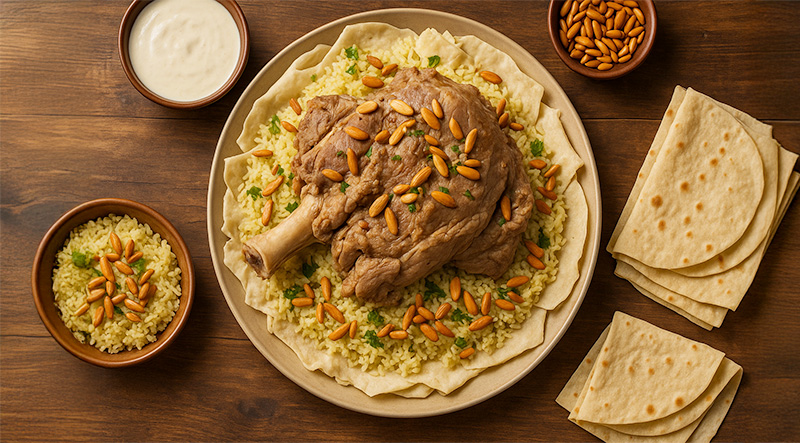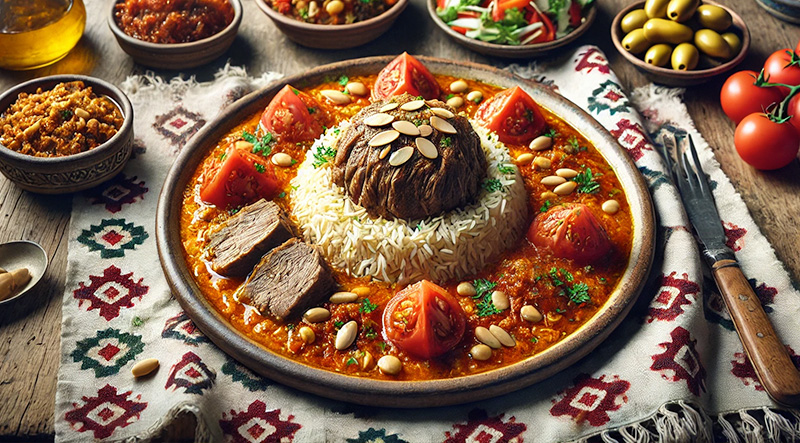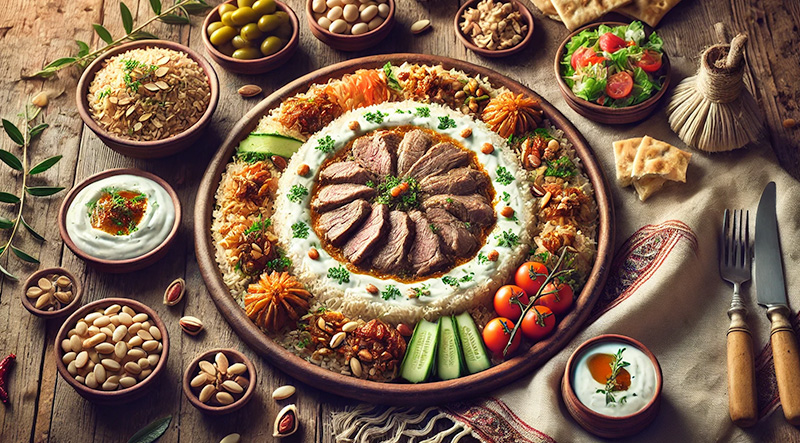A veritable feast for the senses, Mansaf is the essence of Jordanian cuisine—bold, hearty, and steeped in centuries of tradition. Tender, slow-cooked lamb is served with warm flatbread and fragrant rice in this national dish. The lamb is liberally drenched in a rich, tart jamed yogurt sauce and garnished with golden toasted nuts. Mansaf is more than just food; it's a centerpiece at parties, a sign of pride and hospitality, and a potent reminder of Jordan's Bedouin heritage. You can taste the warmth of a country's heritage in just one bite of this savory masterpiece. Read More...
The History of Jordan’s National Dish – Mansaf:
Rich in flavor and deeply rooted in Bedouin heritage, Mansaf is more than just Jordan’s national dish—it’s a powerful symbol of tradition, hospitality, and cultural pride. With its tender lamb, tangy yogurt sauce, and fragrant rice served over flatbread, Mansaf is the centerpiece of Jordanian identity. Its preparation and presentation tell a story that spans centuries, woven through desert landscapes, tribal customs, and communal gatherings.
Bedouin Origins – A Dish Born of the Desert:
Mansaf has its roots in the Bedouin culture of Jordan and the Levant, where food had to be both nourishing and practical. The Bedouins, nomadic desert dwellers, relied on the livestock they raised—particularly sheep and goats—as a primary food source. This explains the central use of lamb in Mansaf, which is slow-cooked to perfection for tenderness and depth of flavor.
But the most distinctive component of Mansaf is jameed—a fermented, dried yogurt made from goat’s or sheep’s milk. Bedouins developed jameed as a way to preserve milk in the hot, dry desert climate. The yogurt was salted, shaped into hard balls, and dried in the sun, making it easy to store and transport. When rehydrated and simmered into a sauce, it creates the tangy, creamy base that defines Mansaf.
From Tribal Tradition to National Icon:
Historically, Mansaf was more than a meal—it was a ritual of generosity and unity. Bedouin tribes would prepare large platters of Mansaf during feasts, weddings, and reconciliations, often serving it communally on a single large platter. Eating it with the right hand, directly from the tray, was part of the custom, emphasizing respect, humility, and trust.
Over time, Mansaf evolved from a tribal dish into a symbol of Jordanian national pride, transcending regional and class boundaries. It became a staple at state functions, religious holidays like Eid, and important family events, such as graduations and homecomings. Today, no Jordanian celebration feels complete without it.
Modern Variations and Cultural Significance:
While the traditional version remains sacred, modern adaptations have emerged. Some recipes substitute chicken for lamb, or use rice instead of bulgur, while others include saffron or turmeric for a golden hue. Despite these changes, the core elements—meat, rice or bulgur, flatbread, jameed sauce, and toasted nuts—remain consistent.
Mansaf also serves as a cultural ambassador of Jordan. It’s taught in culinary schools, served in restaurants across the Middle East, and featured in food festivals around the world. For many Jordanians living abroad, cooking Mansaf is a way to stay connected to home.
More Than Food: A Heritage on a Plate:
Mansaf is more than just Jordan’s national dish—it is a culinary expression of honor, resilience, and belonging. Its preparation honors age-old traditions; its presentation fosters community; and its flavors evoke the warmth of a shared meal in the desert under open skies.
To taste Mansaf is to taste a piece of Jordan’s soul. It’s a dish that nourishes the body, celebrates the land, and unites generations at one table.
Prepare the Jameed Sauce:

Cook the Lamb:
Make the Yogurt Sauce:

Cook the Rice:
Assemble the Mansaf:

Serve Traditionally:
Tips:
The total preparation and cooking time for Mansaf is approximately 2.5 to 3 hours. Prepping the lamb, soaking or blending the jameed, and chopping ingredients typically takes around 30–45 minutes, depending on whether you're using traditional jameed or a shortcut yogurt base. The lamb then needs to simmer for 1.5 to 2 hours until fully tender, during which time you can prepare the rice and toast the nuts. Cooking the rice and heating the jameed sauce takes an additional 20–30 minutes. While it’s a time-intensive dish, much of the process is hands-off, and the result is a deeply flavorful and culturally rich meal worthy of special gatherings.
A single serving of traditional Mansaf, based on the recipe provided, contains approximately 700–900 calories, depending on portion size and specific ingredients used. The primary calorie sources include the lamb (about 250–300 calories per serving), rice (200–250 calories), and the jameed sauce (rich in full-fat yogurt and ghee, contributing around 150–200 calories). Add in the flatbread base (80–100 calories) and toasted nuts (50–100 calories), and you have a hearty, protein-packed, and energy-dense dish. Optional ingredients like extra ghee or nuts can push the total higher, making Mansaf a celebratory and filling meal ideal for special occasions.







